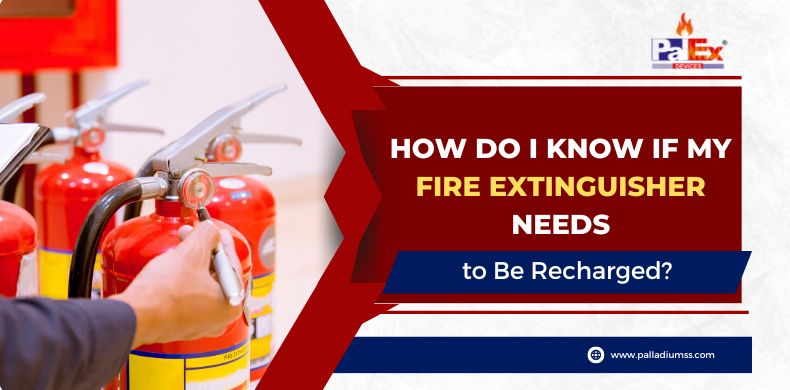Having working fire extinguishers readily available is essential to any fire safety plan, whether for your home or business. However, fire extinguishers can lose pressure or become less effective over time. Knowing when to recharge your extinguishers can ensure they work correctly when needed. This guide will teach you how to inspect your extinguishers and identify when it’s time for professional recharging.
Check the Gauge
Start by locating the gauge on the fire extinguisher. It should be easy to read and clearly show if the extinguisher is in the standard (operable) range. The needle should be in the green zone, indicating adequate pressure. Any reading in the red zone means the pressure has dropped below operable limits and needs recharging. Digital gauges may show normal pressure ranges in psi (pounds per square inch) instead of color zones. But it’s still easy to see if it’s in the ideal range.
Listen and Feel for Contents
Gently rock or invert the extinguisher to determine if the contents are compacted at the bottom or moving freely. You should hear a uniform distribution as you turn it in different directions. Any failure to flow indicates there may be hardened chemical build-up and impending discharge. Extinguisher contents can become compacted over years of vibration in a fixed position. A recharge professional has tools to break this up if found.
Look for Signs of Damage
Give your extinguisher a thorough visual examination to check for any physical damage that could prevent it from working correctly. Specifically, look for:
- Dents, cracks, or holes in the tank
- Rust, corrosion, dings, or scratches
- Missing, broken, or obstructed parts
- An expired pressure gauge
- The pin is missing from the tamper seal
Replace any extinguisher showing signs of physical damage. Even minor issues like a slow leak or pressure gauge past its 5-year lifespan warrant a replacement.
Also read : Enhancing Fire Safety in India’s EV Charging Stations
Note the Manufacture Date
Check the date of manufacture stamped into the extinguisher label or shell. Most household extinguishers expire and require replacement 12 years after this date. Vehicles and commercial extinguishers may need replacement after 5-12 years. Following manufacturer guidelines for replacement based on the stamped date is essential for reliability. Proper function past the expected lifespan cannot be guaranteed even with recharging.
Follow Local Fire Codes
Your local fire inspector may set more stringent requirements on type, placement, inspection schedules, and recharging for fire extinguishers based on building codes and zoning. Always know the ordinances for your municipality regarding extinguishers to stay compliant. Some areas require special permits to keep certain chemical types beyond what’s allowed for home use. Regular professional service checks ensure you meet all local fire codes, too.
When Was It Last Recharged?
Keep a tag or label attached to each extinguisher showing the date of its last recharge. Standard recharging is recommended every 5 or 6 years as contents become less effective. More frequent recharging may be required if an extinguisher is partially used to extinguish a fire. Facilities with hazardous materials often schedule annual recharges well before the 6-year mark. Following recharge schedules is the best way to confirm viability.
DIY vs. Professional Recharging
While some very small extinguishers designed for home kitchens allow DIY recharge cartridge replacement, most do not. Most household and commercial extinguishers require professional recharging to depressurize, thoroughly clean interior components, replace seals, and correctly refill. Improper DIY attempts often fail to meet the fire code or return the extinguisher to full functioning. Always rely on a certified recharge professional rather than trying DIY refilling methods to guarantee reliability.
Recharge After Any Use
You should have your extinguisher fully recharged by a professional after stopping even a tiny fire. The pressure gauge may still read in the operable zone after use, but the extinguishing agents require replacement. Heat and chemical reactions during use may also negatively affect hardware components, even though everything still looks okay externally. Don’t take chances attempting to reuse an extinguisher after any discharge level without having it examined and recharged.
Replace After 12 Years
Most household extinguisher cylinders are only engineered to last for a maximum of 12 years, even with proper recharging. The seals, hoses, and gauges degrade over time. So, no matter how well you maintain an extinguisher, it will eventually need complete replacement based on the manufacture date. Be sure to check the date code and follow recommendations for when to take an expired extinguisher out of service. Trying to push beyond the 12-year lifespan risks failure during emergency use.
Conclusion
Regularly checking your fire extinguishers using these inspection steps lets you know if or when professional recharging becomes necessary. Catching pressure loss early and preventing chemical hardening or build-up through recharging maintains full effectiveness. Stay vigilant with inspections and scheduled recharging to protect your extinguishers as designed year after year. The safety of your family, home, or business relies on having fully functional units ready at a moment’s notice.



